The weather was fair as we sped south towards Huntly that evening in late June of 2009. The colours were magnificent, as low cloud, driven by a southerly breeze, sometimes partly obscured the sun, creating indigo shadows here and there among the golden light which played among the fields, hedgerows and conifer-clad hilltops. We were passing through the parish of Forgue, when the view from my passenger window suddenly yielded a sight which made me catch my breath in wonderment.
Above the roadside hedgerow had appeared the top of a tall single crowstep gable which adjoined an almost-complete four-storey wall. A tree was growing in the space which had obviously been occupied by whatever had been between this wall and gable and its now absent counterparts. In the prevailing light of that evening, the sight was spectacular. I asked my companion what this building had been, and exposed a gap in her hitherto comprehensive knowledge of the area. I was determined that, on my return to Shetland, I would find out what I could about this magnificent ruin.
The OS map of the area revealed it to be Conzie Castle. Further online investigation led me to the fact that it had also been known as Bognie House, and it had been built, around 1670, by one George Morison, who had acquired much of the land in this area, through forfeiture, from Viscount Frendraught, who had taken the losing Royalist side, alongside the Marquis of Montrose, in the Scottish episodes of the Civil war of the mid-17th century. According to the Canmore site record, the building is "a tall four storey rectangular un-vaulted palatial structure, with crowstep gables and the remains of corner turrets". An ambitious project, then, but now it's a ruin, standing in a field, without even a footpath leading to it, as far as I can see.
Why Morison built Conzie/Bognie Castle is unclear, but it seems that it was never lived in. There had been an earlier, equally imposing building (Pennyburn) to the east of Conzie, as a map of 1776 shows two mansions on the Bognie estate. The ruins of a "dookit" also stand quite near to the east of Conzie, although no trace remains of Pennyburn, apart from the stream which gave the building its name.
Later that summer, I returned to Banff, where I had been staying when I discovered Conzie, to take down my paintings exhibition at Duff House. The setting up of this display had earlier led me to this car journey down the A97. My brother was helping me with the transport of the pictures, and he agreed to my suggestion of a run down to Huntly for our lunch, so that I could get another look at Conzie. On this occasion, however, the weather was not so kind. It had rained for about 24 hours (and most of the intervening summer apparently!), and this had just cleared when we reached the castle ruin. It was difficult to find a place to stop on this fast section of roadway, and, when we did, I got a few photographs of the grey sodden-looking scene, in which the rosebay willowherb seemed to be the only thing thriving in the conditions. Everything else looked defeated and depressed somehow.
So what you see above is my attempt to re-create a moment in time, a fleeting glimpse of a spectacular ruin on a June evening more than three years ago. It has taken me four months of intermittent effort to get close to that, and this is all that we poor artists can do. This is the third of the must-paint scenes which stem from the journey of that magical evening, the others being Fordyce and Boyndie Bay. Enjoy!
The Grumpy Old Artist
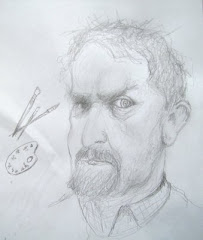
Would YOU pose for this man???
Exhibition Poster

Catterline Event, 2011
Oil Painting by Jim Tait
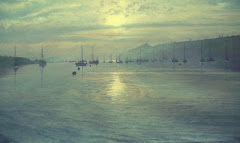
Helford River, Cornwall
Oil Painting by Jim Tait
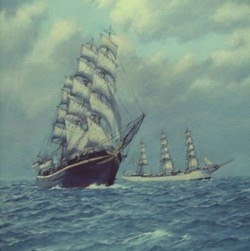
Full-riggers "Georg Stage" and "Danmark"
Other Recent Works
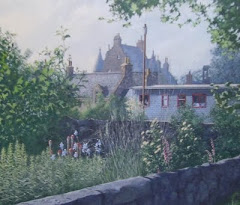
Fordyce Castle and Village

Hay's Dock, Lerwick

Shetland-model Boats at Burravoe, Yell
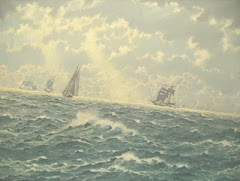
Tall Ships Seascape

The Tour Boat "Dunter III", with Gannets, off Noss
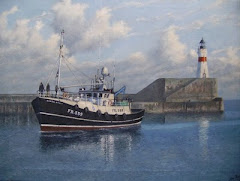
The "Karen Ann II" entering Fraserburgh harbour
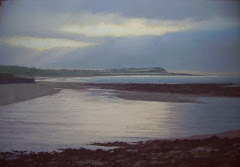
Summer Evening, Boyndie Bay
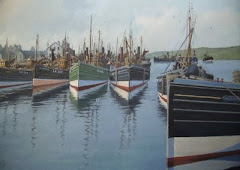
1930s Lerwick Harbour

Johnshaven Harbour
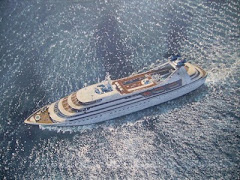
"Seabourn Legend"
Greeting Cards!

Now Available in Packs of Five or in Assorted Sets of Four
Sunday, 30 September 2012
Sunday, 23 September 2012
THE BRESSAY LIGHT
I wonder just how often I've painted pictures of the Bressay lighthouse over the years. It must be of the order of a hundred times, considering the different viewpoints, and it was nearly always as a background feature to some ship or other making its entrance to (or exit from) Lerwick harbour. I observe that, of the five paintings I have "on the stocks" at the moment, two of them fall into this category.
The lighthouse has stood there for a hundred and fifty years, and will probably stand for a hundred and fifty more. One Swedish yachtsman of my acquaintance describes it in his log-book as like a white monastery, in the account of his first trip to Shetland many years ago. It will probably never provide a cloistered existence, but the buildings have been used as self-catering accommodation (for monks and any other visitors who choose to stay there) since the Stevenson-designed lighthouse went automatic around 1990. Before then, the living quarters were for the keepers and their families.
But, for a century and a half, the light has flashed out its double signal in the darkness, visible (assuming clear enough conditions) for 23 miles. It could be seen from ships passing south of Sumburgh Head, in "da Roost" (the tide-race which reminds sea-travellers that our archipelago is set between the North Sea and the Atlantic Ocean). It was always there, a regular blink of reassuring white against the surrounding pitch-blackness of everything else. That is, until a week past Wednesday, when the beam was turned off - for good.
It has been replaced (through the good offices of Lerwick Port Authority, not the Lighthouse Board) by a lower-situated LED device which is visible for ten miles. This is quite adequate for vessels approaching or leaving the harbour, and most boats have sophisticated electronic navigation equipment, which renders extraneous visual landmarks unnecessary (until the technology breaks down, that is!).
What's my problem with the old light being turned off, then? Well, for a start, I liked it there, as did most other people living within the scope of its beam, and there are too many things being arbitrarily shut down, turned off or otherwise terminated nowadays. And, even with the bank of electronic navigation equipment in front of him, the watchman in the wheelhouse of the fishing boat passing through "da Roost" still liked to cast his eye out the starboard window (if the boat was steaming east) to catch sight of the distant white blink and have his bearings (psychologically as well as electronically and navigationally) confirmed.
Seafarers (and others) like visual points of reference like lighthouse beams in their lives. In Basil R J Anderson's Shetland dialect poem "Maunsie's Crö", the poet tells how the crö (a circular stone enclosure for growing plants) on the hilltop, although never having been intended for this purpose, became a "meead" bearing for fishermen out at sea, and there have been many examples of real-life "crös". One such was the red light on top of the main TV transmitter mast on the Wart of Bressay. It was removed in 1990, but, because of its intensity and height (about 900ft) above sea level, it could be seen by boats up to forty miles out to sea to the east of the islands, and it became a well-known night landmark for fishermen from a' the airts working the fishing grounds in that area.
And the reason for the Bressay light being switched off? I'm afraid that it comes down to that old chestnut again - money, or the recently-perceived lack of it! It's just another example of how the government is trying to save a few quid by squeezing the budgets of the various agencies, departments, quangoes and local authorities, and this includes the Northern Lighthouse Board. Our historical beacon has become another casualty of a corporate strategy which defines price without admitting any consideration of value in its cost-cutting exercises.
We can only speculate as to what beacon might be next on the chop list. The road up to Sumburgh Head is close to collapse under the weight of Amenity Trust plans for the lighthouse buildings there. I don't suppose these include any safeguards for the future of the triple-flash beam sequence which was a background feature of my formative years at Sandwick schoolhouse. It would be a fortunate result of this little personal piece of prose, if the bodies which are addressing themselves so zealously to the "slockin" of lighthouse beams and other elements of our lives' facilities, that it may be much more than a flash in the dark they are extinguishing.
The lighthouse has stood there for a hundred and fifty years, and will probably stand for a hundred and fifty more. One Swedish yachtsman of my acquaintance describes it in his log-book as like a white monastery, in the account of his first trip to Shetland many years ago. It will probably never provide a cloistered existence, but the buildings have been used as self-catering accommodation (for monks and any other visitors who choose to stay there) since the Stevenson-designed lighthouse went automatic around 1990. Before then, the living quarters were for the keepers and their families.
But, for a century and a half, the light has flashed out its double signal in the darkness, visible (assuming clear enough conditions) for 23 miles. It could be seen from ships passing south of Sumburgh Head, in "da Roost" (the tide-race which reminds sea-travellers that our archipelago is set between the North Sea and the Atlantic Ocean). It was always there, a regular blink of reassuring white against the surrounding pitch-blackness of everything else. That is, until a week past Wednesday, when the beam was turned off - for good.
It has been replaced (through the good offices of Lerwick Port Authority, not the Lighthouse Board) by a lower-situated LED device which is visible for ten miles. This is quite adequate for vessels approaching or leaving the harbour, and most boats have sophisticated electronic navigation equipment, which renders extraneous visual landmarks unnecessary (until the technology breaks down, that is!).
What's my problem with the old light being turned off, then? Well, for a start, I liked it there, as did most other people living within the scope of its beam, and there are too many things being arbitrarily shut down, turned off or otherwise terminated nowadays. And, even with the bank of electronic navigation equipment in front of him, the watchman in the wheelhouse of the fishing boat passing through "da Roost" still liked to cast his eye out the starboard window (if the boat was steaming east) to catch sight of the distant white blink and have his bearings (psychologically as well as electronically and navigationally) confirmed.
Seafarers (and others) like visual points of reference like lighthouse beams in their lives. In Basil R J Anderson's Shetland dialect poem "Maunsie's Crö", the poet tells how the crö (a circular stone enclosure for growing plants) on the hilltop, although never having been intended for this purpose, became a "meead" bearing for fishermen out at sea, and there have been many examples of real-life "crös". One such was the red light on top of the main TV transmitter mast on the Wart of Bressay. It was removed in 1990, but, because of its intensity and height (about 900ft) above sea level, it could be seen by boats up to forty miles out to sea to the east of the islands, and it became a well-known night landmark for fishermen from a' the airts working the fishing grounds in that area.
And the reason for the Bressay light being switched off? I'm afraid that it comes down to that old chestnut again - money, or the recently-perceived lack of it! It's just another example of how the government is trying to save a few quid by squeezing the budgets of the various agencies, departments, quangoes and local authorities, and this includes the Northern Lighthouse Board. Our historical beacon has become another casualty of a corporate strategy which defines price without admitting any consideration of value in its cost-cutting exercises.
We can only speculate as to what beacon might be next on the chop list. The road up to Sumburgh Head is close to collapse under the weight of Amenity Trust plans for the lighthouse buildings there. I don't suppose these include any safeguards for the future of the triple-flash beam sequence which was a background feature of my formative years at Sandwick schoolhouse. It would be a fortunate result of this little personal piece of prose, if the bodies which are addressing themselves so zealously to the "slockin" of lighthouse beams and other elements of our lives' facilities, that it may be much more than a flash in the dark they are extinguishing.
Sunday, 9 September 2012
L'ENNUI AND KEITH RICHARDS
I know I shouldn't , but I'm so bored that I've decided to upload this JPEG of my painting of the rock legend, and to heck with the consequences! A friend of mine commissioned the work, and I'm profiting none financially by publishing it here, so I hope I'll get away with it.
Once again, I have found myself, as I have on other Sundays, in front of a blank page, hoping that the Muse will return soon from her sick leave. Seldom have I felt less motivated to either paint, write, or otherwise create anything at all, than I have during this non-event of a Shetland summer. The artwork I have been doing has been mostly on commissions, and I have no exhibitions planned for the foreseeable future. I entered my "Lower Voe" painting for the Oldie British Art Award competition, and it didn't make the short-list of ten. This came as something of a relief to me, as the problems associated with getting the obligatory portfolio of work and myself from Shetland to London (which would be an obligation for finalists) was causing me some anxiety, as I don't have either a car or a licence to drive one, and I've never been to the Metropolis before! My feet are of a particularly claggy form of clay, and I've never had any desire to travel - anywhere!
A lot of my time, over recent months, has been spent clearing out my mother's home at Whiteness, to get the place ready for the new occupants, who will be moving in in the next month or so. My sisters and I, ably supported by my nephew Kenneth with a hired van, have been carting tons of stuff off to the Rova Head dump, and putting further copious quantities of clothes, furnishings and bric-a-brac to charity shops in Lerwick. I was surprised when the local re-cycling firm Shetland Scrapstore accepted three old typewriters for their renovation enterprise scheme. A numismatist is to visit me on Tuesday to look at my late father's coin collection (which he kept in two old sweetie tins in the bureau of his study), and I've made up a package of over a hundred used foreign stamps, off the many letters and postcards we found, which I'm sending off to the MS Society of Scotland, in the hope that they can still use them.
And all the time we have the uneasy feeling that we are callously and arbitrarily trashing the life of our dear mother, who now resides, apparently quite happily, in the Overtonlea Care Centre at Levenwick, a parish in the south mainland of Shetland. The stage had been reached when she was no longer able to live in her own home, and she had become resigned to this fact when the vacancy arose at the centre at the end of April. Since then, we have all been engaged in the various practicalities and administrative matters to do with her change in residential status and the sale of the house. For nearly sixteen years, ever since my father died in October 1996, I have been my mother's care attendant, getting her shopping and pension, doing bits and pieces of work around the house and garden, helping her with appointments at various places, and any other matters arising. None of it has felt at all burdensome to me, and I feel rather out on a limb now that the moment (which I have known was approaching for the past sixteen years) when my attendant services would no longer be required, has arrived.
Now, for the first time in my life, I feel a little lonely and vulnerable. Long ago, I would have dispelled such negativity at the pub, life always having looked rosier through the bottom of a pint-glass. But that was in a sweeter bygone age, when bars were warm, friendly and exciting places where dreams and schemes would materialise and fade among my smoke-rings. Since the Scottish government's Pick-A-Soft-Target-and-Hit-It-Hard act, pubs have taken on the clinical atmosphere of a dentist's waiting-room, much fewer people bother to go now, and many bars are closing down as an inevitable consequence. I think the last time I visited my local (the Lounge!) was back in May, when friends of mine were up in Shetland for the Classic Motor Show.
In short, the only way I can avoid boring myself to tears is to work, and, in my line as a professional artist, it's difficult to maintain a consistent level and standard of work over prolonged periods of time. One needs to re-charge the batteries, so to speak, and that seems to be what I have been doing lately. I just hope the gauge registers "full" soon.
Once again, I have found myself, as I have on other Sundays, in front of a blank page, hoping that the Muse will return soon from her sick leave. Seldom have I felt less motivated to either paint, write, or otherwise create anything at all, than I have during this non-event of a Shetland summer. The artwork I have been doing has been mostly on commissions, and I have no exhibitions planned for the foreseeable future. I entered my "Lower Voe" painting for the Oldie British Art Award competition, and it didn't make the short-list of ten. This came as something of a relief to me, as the problems associated with getting the obligatory portfolio of work and myself from Shetland to London (which would be an obligation for finalists) was causing me some anxiety, as I don't have either a car or a licence to drive one, and I've never been to the Metropolis before! My feet are of a particularly claggy form of clay, and I've never had any desire to travel - anywhere!
A lot of my time, over recent months, has been spent clearing out my mother's home at Whiteness, to get the place ready for the new occupants, who will be moving in in the next month or so. My sisters and I, ably supported by my nephew Kenneth with a hired van, have been carting tons of stuff off to the Rova Head dump, and putting further copious quantities of clothes, furnishings and bric-a-brac to charity shops in Lerwick. I was surprised when the local re-cycling firm Shetland Scrapstore accepted three old typewriters for their renovation enterprise scheme. A numismatist is to visit me on Tuesday to look at my late father's coin collection (which he kept in two old sweetie tins in the bureau of his study), and I've made up a package of over a hundred used foreign stamps, off the many letters and postcards we found, which I'm sending off to the MS Society of Scotland, in the hope that they can still use them.
And all the time we have the uneasy feeling that we are callously and arbitrarily trashing the life of our dear mother, who now resides, apparently quite happily, in the Overtonlea Care Centre at Levenwick, a parish in the south mainland of Shetland. The stage had been reached when she was no longer able to live in her own home, and she had become resigned to this fact when the vacancy arose at the centre at the end of April. Since then, we have all been engaged in the various practicalities and administrative matters to do with her change in residential status and the sale of the house. For nearly sixteen years, ever since my father died in October 1996, I have been my mother's care attendant, getting her shopping and pension, doing bits and pieces of work around the house and garden, helping her with appointments at various places, and any other matters arising. None of it has felt at all burdensome to me, and I feel rather out on a limb now that the moment (which I have known was approaching for the past sixteen years) when my attendant services would no longer be required, has arrived.
Now, for the first time in my life, I feel a little lonely and vulnerable. Long ago, I would have dispelled such negativity at the pub, life always having looked rosier through the bottom of a pint-glass. But that was in a sweeter bygone age, when bars were warm, friendly and exciting places where dreams and schemes would materialise and fade among my smoke-rings. Since the Scottish government's Pick-A-Soft-Target-and-Hit-It-Hard act, pubs have taken on the clinical atmosphere of a dentist's waiting-room, much fewer people bother to go now, and many bars are closing down as an inevitable consequence. I think the last time I visited my local (the Lounge!) was back in May, when friends of mine were up in Shetland for the Classic Motor Show.
In short, the only way I can avoid boring myself to tears is to work, and, in my line as a professional artist, it's difficult to maintain a consistent level and standard of work over prolonged periods of time. One needs to re-charge the batteries, so to speak, and that seems to be what I have been doing lately. I just hope the gauge registers "full" soon.
Subscribe to:
Comments (Atom)










